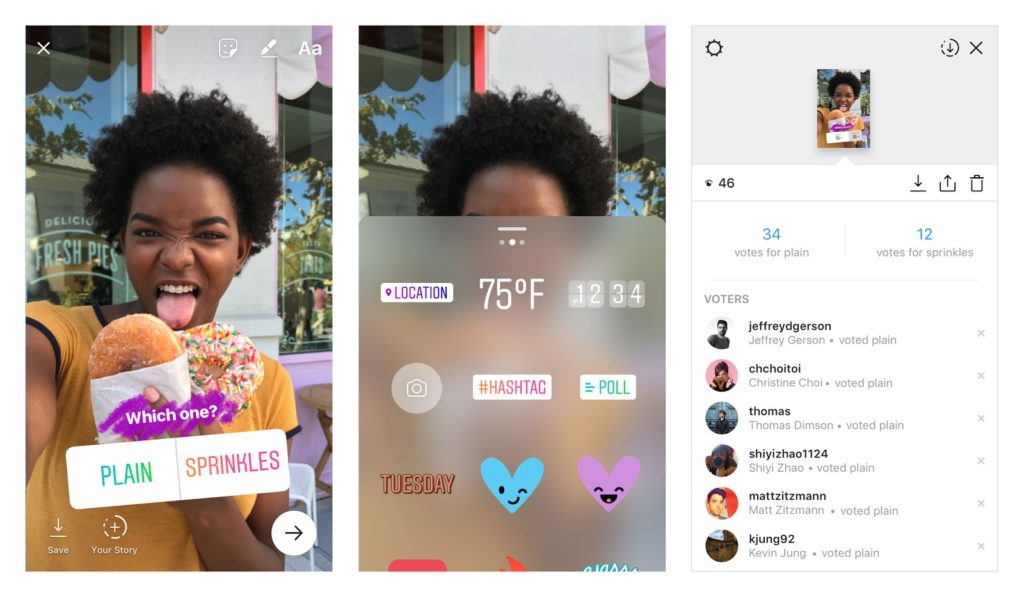Over the past few years the content format has steadily become more prominent on the social network, and it’s now considered so important that Mark Zuckerberg—CEO of parent company Facebook—has declared it the future of the service.
What’s the big deal? What makes Stories different? Why is Instagram so bullish on the feature? How can brands effectively utilize it?
Here are 10 key things marketers need to know about the Instagram Stories experience.
1. The Stories format is unique.
The Instagram Stories format is a string of vertically-oriented, mixed-media content pieces created by the user. While the building blocks (images and videos) are the same as posts, the Instagram Stories experience is fundamentally different.
This is in part because of the ephemeral nature of Stories: They disappear after 24 hours (with one exception). It’s also because of how they are displayed. The continuous, full-screen experience feels more immersive compared with looking at individual posts within a feed.

2. The Stories format is mobile first.
Part of what makes the Stories format different is that it was developed during the smartphone era. So, while other social media experiences such as the Facebook News Feed were structured originally for computers, Stories has always been mobile first.
This is apparent in everything from the orientation of Stories (vertical) to the interface (taps and swipes).
Given that more than half of Internet traffic is now driven by smartphones and tablets, the mobile-first nature of Stories has been key to both powering its growth and setting it up for future success.
3. Stories enables incredible creativity.
Part of what’s great about the Stories format is that it enables people to unleash their creativity.
In addition to being able to overlay things like text and emojis onto Stories content, users can also add interactive elements such as polls and augmented reality face filters. For the latter, it’s now even possible for individuals and brands to create their own.
All of this adds up to Stories being incredibly fun not only to experience, but also to create.

4. The feature is wildly popular.
It’s important to note that Instagram did not pioneer Stories: The platform borrowed/stole it from Snapchat.
However, Instagram and parent company Facebook have been instrumental in making Stories popular.
Just how popular? More than 1.5 billion people now regularly use the format across Facebook’s platforms, with 500+ million engaging with Stories on Instagram alone.
5. Younger consumers in particular love Stories.
The mobile-first, ephemeral, and creative nature of Stories has made the format popular with all demographics.
That said, one group in particular has been especially passionate in its embrace of Stories—younger consumers.
Some 70% of Gen Z Americans (age 16 to 24) and some 58% of Millennials (age 25 to 34) say they use stories on Instagram. This means if marketers want to connect with younger audiences, utilizing Stories is increasingly essential.
6. Instagram is all-in on Stories.
Instagram has clearly taken note of how much audiences love Stories. In fact, the feature, which initially started out as an experiment, has become foundational to the service.
This can be seen in how Stories has increasingly taken up more and more real estate over time at the top of the Instagram Stories experience—something especially important on smaller smartphone screens.
Essentially, Instagram has gone all-in on Stories, prioritizing it over traditional posts. For brands looking to reach consumers on the social network, that’s a key thing to keep in mind.
7. Stories are for brands, too.
Many marketers have been unsure how to approach Stories. That’s in part because the hodgepodge, disappearing nature of the format makes it feel like it’s meant more for person-to-person interactions rather than for brand-to-person interactions.
In truth, audiences want marketers to engage: A survey of social media users in 12 countries found 69% think Stories is a great way for brands to showcase new products/services. In addition, 62% say they have become more interested in a brand or product after seeing it in Stories.
An important thing to note is that marketers shouldn’t simply recycle content from posts in Stories and expect to succeed. Instagram users are accustomed to seeing unique Stories content from each other, and they expect the same from brands.
8. Influencers are key to Stories marketing.
So, how can your brand create authentic, original Stories? One effective approach is to turn to influencers.
That’s because today’s social media stars are deeply engaged in creating Stories. In fact, according to an analysis conducted by the Influencer Marketing platform Klear, more than a third of all sponsored pieces from Instagram influencers are now Stories.
This doesn’t mean brands should shy away from creating Stories themselves. Rather, to connect with audiences effectively, brands should consider both publishing their own pieces as well as partnering with influencers to develop content.
9. There are compelling paid options for Stories.
A key thing for marketers to remember about Stories is that they’re not only for organic engagement.
Over the past few years Instagram has developed compelling Stories ad units that make effective use of the format’s capabilities.
Moreover, because the social network is owned by Facebook, Instagram Stories ads are integrated into the company’s advertising platform. This means Stories units can be targeted in all sorts of sophisticated ways, such as for reach, views, traffic, conversions, app installs, and brand awareness.
10. Things are just getting started with Stories.
Finally, here’s some food for thought: Stories was only introduced on Instagram in 2016.
In other words, the Instagram Stories experience is still developing. Audiences are still finding new ways to use the format’s existing tools, and Instagram is still adding new features. For example, the social network recently started testing Reels mode, which mimics TikTok and allows users to edit and remix short videos within Stories.
Ultimately, these evolutions highlight a very important fact: The Stories format is just getting started.





Join the conversation